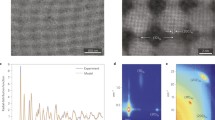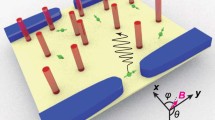Abstract
From first principles, we arrive at a generalized Tsu–Esaki formula for current per unit-cell in the case of one-dimensional, time-independent, open-system charge-transport along the growth direction of stacked layers of self-assembled quantum dots with perfect, transverse Bravais-lattice layout. We rigorously derive, using symmetry considerations, great simplifications to the final formula and identify significant computational benefits that would make modeling and simulation for such a complex problem not only feasible but also efficient. We allow an arbitrary sequence of quantum dot layers with or without intervening spacer and wetting layers. While the symmetry does suggest that final expressions for transmission coefficients should have simple form, the split, open boundary conditions as well as lack of longitudinal symmetry cast doubt on this. Employing a multiple sequential scattering view of processes within the heterostructure layers and using a limiting argument, we prove that the device behaves as a diffraction grating which distributes incident-carrier wavefunction-phases into specific patterns of reflected and transmitted phases which forms the basis for our conclusions.

Similar content being viewed by others
References
Wasilewski, Z.R.; Fafard, S.; McCaffrey, J.P.: Size and shape engineering of vertically stacked self-assembled quantum dots. J. Crystal Growth 201, 202, 1131–1135 (1999)
Leonard, D.; Krishnamurthy, M.; Reaves, C.M.; Denbaars, S.P.; Petroff, P.M.: Direct formation of quantum-sized dots from uniform coherent islands of InGaAs on GaAs surfaces. Appl. Phys. Lett. 63, 3203 (1993)
Moison, J.M.; Houzay, F.; Barthe, F.; Leprince, L.; André, E.; Vatel, O.: Self-organized growth of regular nanometer-scale InAs dots on GaAs. Appl. Phys. Lett. 64, 196 (1994)
Xu, M.C.; Temko, Y.; Suzuki, T.; Jacobi, K.: Shape transition of self-assembled inas quantum dots on gaas(114)a. Phys. Rev. B (Condensed Matter and Materials Physics) 71(7), 075314 (2005)
Joyce, P.B.; Krzyzewski, T.J.; Bell, G.R.; Jones, T.S.; Malik, S.; Childs, D.; Murray.R.: Effect of growth rate on the size, composition, and optical properties of InAs/GaAs quantum dots grown by molecular-beam epitaxy. Phys. Rev. B 62(16), 10891–10895 (2000)
Lee H., Lowe-Webb R., Yang W., Sercel P.C.: Determination of the shape of self-organized inas/gaas quantum dots by reflection high energy electron diffraction. Appl. Phys. Lett. 72(7), 812–814 (1998)
Zhang K., Falta J., Schmidt Th., Heyn Ch., Materlik G., Hansen W.: Distribution and shape of self-assembled InAs quantum dots grown on GaAs (001). Pure Appl. Chem. 72(1–2), 199–207 (2000)
Lehmann, S.Y.; Roshko, A.; Mirin, R.P.; Bonevich, J.E.: Investigation of shape of ingaas/gaas quantum dots. Mater. Res. Soc. Sympos. Proc. 737, E13.40.1–E13.40.6 (2003)
Leonard D., Pond K., Petroff P.M.: Critical layer thickness for self-assembled InAs islands on GaAs. Phys. Rev. B 50(16), 11687–11692 (1994)
Saito H., Nishi K., Sugou S.: Shape transition of InAs quantum dots by growth at high temperature. Appl. Phys. Lett. 74(9), 1224 (1999)
Eberl, K.; Lipinski, M.O.; Manz, Y.M.; Winter, W.; Jin-Phillip, N.Y.; Schmidt, O.G.: Self-assembling quantum dots for optoelectronic devices on si and gaas. Phys. E 9, 164–174 (2001)
Kurtz E., Shen J., Schmidt M., Grün M., Hong S.K., Litvinov D., Gerthsen D., Oka T., Yao T., Klingshirn C.: Formation and properties of self-organized II–VI quantum islands. Thin Solid Films 367(1–2), 68–74 (2000)
Springholz G., Holy V., Pinczolits M., Bauer G.: Self-organized growth of three-dimensional quantum-dot crystals with fcc-like stacking and a tunable lattice constant. Science 282, 734–737 (1998)
Okada, Y.; Akahane, K.; Iuchi, Y.; Kawabe, M.: Probing the properties of self-organized ingaas quantum dots on gaas (311)b and (001) by conductive atomic force microscope tip. Mater. Res. Soc. Sympos. Proc. 642, J.4.7.1–J.4.7.6 (2001)
Bortoleto J.R.R., Zelcovit J.G., Gutierrez H.R., Bettini J., Cotta M.A.: Designing spatial correlation of quantum dots: towards self-assembled three-dimensional structures. Nanotechnology 19(1), 015601 (2008)
Ledentsov, N.N.; Shchukin, V.A.; Grundmann, M.; Kirstaedter, N.; öhrer, J.B; Schmidt, O.; Bimberg, D.; Ustinov, V.M.; Yu. Egorov, A.; Zhukov, A.E.; Kop’ev, P.S.; Zaitsev, S.V.; Yu. Gordeev, N.; Alferov, Zh. I.; Borovkov, A.I.; Kosogov, A.O.; Ruvimov, S.S.; Werner, P.; ösele, U.G; Heydenreich, J.: Direct formation of vertically coupled quantum dots in stranski-krastanow growth. Phys. Rev. B 54(12), 8743–8750 (1996)
Schmidt, O.G.; Denker, U.; Eberl, K.; Kienzle, O.; Ernst, F.; Haug, R.J.: Resonant tunneling diodes made up of stacked self-assembled ge/si islands. Appl. Phys. Lett. 77, 4341 (2000)
Sun J.P., Haddad G.I., Mazumder P., Schulman J.N.: Resonant tunneling diodes: models and properties. Proc. IEEE 86(4), 641–660 (1998)
Datta S.: Electronic Transport in Mesoscopic Systems. Cambridge Studies in Semiconductor Physics and Microelectronic Engineering. Cambridge University Press, Cambridge (1997)
Bimberg D., Grundmann M., Ledentsov N.N.: Quantum Dot Heterostructures. Wiley, New York (1999)
Tsu R., Esaki L.: Tunneling in a finite superlattice. Appl. Phys. Lett. 22(11), 562–564 (1973)
Streetman, B.G.; Banerjee, S.: Solid State Electronics, 6th edn. Prentice Hall, Englewood Cliffs (2000)
BenDaniel D.J., Duke C.B.: Space-charge effects on electron tunneling. Phys. Rev. 152(2), 683–692 (1966)
Coon D.D., Liu H.C.: Tunneling currents and two-body effects in quantum well and superlattice structures. Appl. Phys. Lett. 47(2), 172–174 (1985)
Bandara K.M.S.V., Coon D.D.: Derivation and correction of the tsu-esaki tunneling current formula. J. Appl. Phys. 66(2), 693–696 (1989)
Merzbacher E.: Quantum Mechanics, 3rd edn. Wiley, New York (1998)
Ashcroft, N.W.; David Mermin, N.: Solid State Physics. Brooks Cole (1976)
Blanes S., Casas F., Oteo J.A., Ros J.: Magnus and fer expansions for matrix differential equations: the convergence problem. J. Phys. A Math. Gen., 31(1), 259–268 (1998)
Hall, B.C.: Lie Groups, Lie Algebras, and Representations: An Elementary Introduction. Graduate Texts in Mathematics. Springer, New York (2004)
Bastard, G.; Furdyna, J.K.; Mycielski, J.: Landau levels and cyclotron resonance in graded mixed semiconductors. Phys. Rev. B 12(10), 4356–4359 (1975)
Ko D.Y.Y., Inkson J.C.: Matrix method for tunneling in heterostructures: resonant tunneling in multilayer systems. Phys. Rev. B 38(14), 9945–9951 (1988)
Author information
Authors and Affiliations
Corresponding author
Rights and permissions
About this article
Cite this article
Rajagopalan, M., Mazumder, P. Tunneling Through Finite Quantum Dot Superlattices. Arab J Sci Eng 39, 1863–1879 (2014). https://doi.org/10.1007/s13369-013-0806-8
Received:
Accepted:
Published:
Issue Date:
DOI: https://doi.org/10.1007/s13369-013-0806-8




